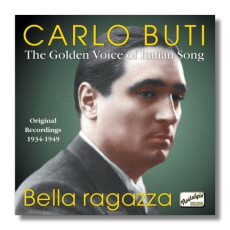
The Internet's Premier Classical Music Source
Related Links
- Latest Reviews
- More Reviews
-
By Composer
-
Collections
DVD & Blu-ray
Books
Concert Reviews
Articles/Interviews
Software
Audio
Search Amazon
Recommended Links
Site News
 CD Review
CD Review
Carlo Buti

Bella ragazza
Original Recordings 1934-1949
- Bella Ragazza Dalle Trece Bionde
- Sul Lungarno (Stornellata Fiorentina)
- 'o Balcone 'e Napule
- Sorrento
- Carioca, Carioca…!
- Resta Con Me
- Fantasia D' 'e Vase
- Due Chitarre
- Mattinatella
- Dove Sta Zaza?
- Io Pe' Te Moro!
- Chitarrata A Chi Sente
- Munasterio 'e Santa Chiara
- Verde Luna
- Ponti Sull'arno
- Malinoconia Di Capri
- Ritorna Amor
- Tutt' 'e Sere
- La Vita 'e Rosa
Carlo Buti, tenor
Various accompaniments
Naxos Nostalgia 8.120596 ADD monaural 63:22
Crooning is not indigenous to the United States. Germans croon (listen to a Dietrich Fischer-Dieskau recording!) and so do Italians. Near the end of his career, Beniamino Gigli crooned with the best of them to compensate for fading vocal resources. As far as crooning goes, however, Gigli was outdone by his contemporary and compatriot Carlo Buti, whose popularity more than 40 years after his death continues on.
Buti, who was born in 1902, received some operatic training (his teacher, Raoul Frazzi, also trained renowned baritone Gino Bechi), but I don't think he ever stood much chance of making a serious operatic career, at least onstage – his voice was too small. (He might have become a "gramophone tenor," much like Andrea Bocelli is today.) He quickly found his niche as a singer of popular material in a sentimental style. His sweet little voice was well-suited to romantic ballads, and to tangos and other dance-genres of the era. He rarely ventured above a mezzo piano dynamic, and high notes, when they were needed, were executed not from the chest but in a heart-melting falsetto. It is likely that many a couple, Italian or otherwise, fell in love and then noisily consummated their relationship to the dulcet tones of Carlo Buti.
Strictly classical listeners might sniff at Buti much as they sniff at Mario Lanza, but it is worth noting that the first selection on this CD, "Bella ragazza delle trecce bionde" (Pretty girl with the blonde tresses) is based on the same tune that Tchaikovsky used in his Capriccio italien. (Apparently Tchaikovsky heard a juvenile street-singer croon the same tune during his Italian visit. It's amazing how these things endure.)
These 17 recordings were made between 1934 and 1949, with a big gap during the years of World War Two. Apparently, Buti managed to weather the war politically, as he performed in Carnegie Hall in 1948, a decade after having conquered New York City (and not just those dwelling in Little Italy!) for the first time.
There are few truly memorable songs here, but this compilation is as pleasant as a late-night glass of Sambuca. Close your eyes and you may well see the stars of an Italian night as your father or grandfather might have seen it during the war. All of the songs are in Italian (even "La vie en rose," which Buti appropriated from Piaf!). There are no translations in the booklet, but I suspect the words don't matter all that much. Buti performs with a variety of small orchestras and dance bands in the period style. Some of the 78-rpm records are showing their age, in spite of excellent noise reduction by Peter Dempsey, who also wrote the booklet notes. This did not spoil my enjoyment.
If you're just a sentimental softy with a taste for Chianti, get this.
Copyright © 2004, Raymond Tuttle



















